CICS维护手册
CICS经典教程

level language translator SYSPUNCH (translated source program)
Compilation
High-level language compiler
High-level language compiler listing
Object module Link-editor listing Load library
事务程序的主要工作
从显示或其他设备获得输入信息
做被请求的实际工作
产生回应并可能将回应送回提供输入 的设备
事务处理应用程序
为实现所给定的商务活动的自动化而设计的一 组事务程序的集合称为事务处理应用程序 收集输入以提供给事务程序,即收集用户提供 的输入,并将其转化成通信消息 获得通信消息并将其转化成对合适的事务程序 的调用
执行要求以履行用户所期待的工作,典型的是 读写数据库,也可能是调用其他程序,它可能 返回一个应答给提供输入请求的设备
事务管理器
对应用程序提供服务的、将应用程序与复杂系 统软件和硬件分离开的一层软件,也称为中间 件
CICS 程序
EDIT BDVLP.NEW1.SOURCE(TXOI01) - 01.01 Member TXOI01 saved Command ===> Scroll ===> CSR ****** ***************************** Top of Data ****************************** 000001 000100 IDENTIFICATION DIVISION. 000002 000200 PROGRAM-ID. TXOI01. 000003 000300*---CICS 課程習題範本一。 000004 000400 AUTHOR. 11166. 000005 000500 DATE-WRIITEN. 08/10/1999. 000006 000600 DATE-COMPILED. 000007 000700 REMARKS. 000008 000800*----------------------------------------------------------------* 000009 000900* 1. INPUT : NO * 000010 001000* 2. OUTPUT : SEND TEXT ONTO SCREEN * 000011 001100* 2. LANGUAGE 1. VS COBOL II(ANSI 85) / CICS * 000012 001200* 3. TRANSID 1. TX01. * 000013 001300*----------------------------------------------------------------* 000014 001400 ENVIRONMENT DIVISION. 000015 001500 CONFIGURATION SECTION. 000016 001600 SOURCE-COMPUTER. IBM-9672. 000017 001700 OBJECT-COMPUTER. IBM-9672. 000018 001800 DATA DIVISION. 000019 001900*-
CICS 事务服务器 for z OS 版本 4 第 1 版应用程序编程指南说明书
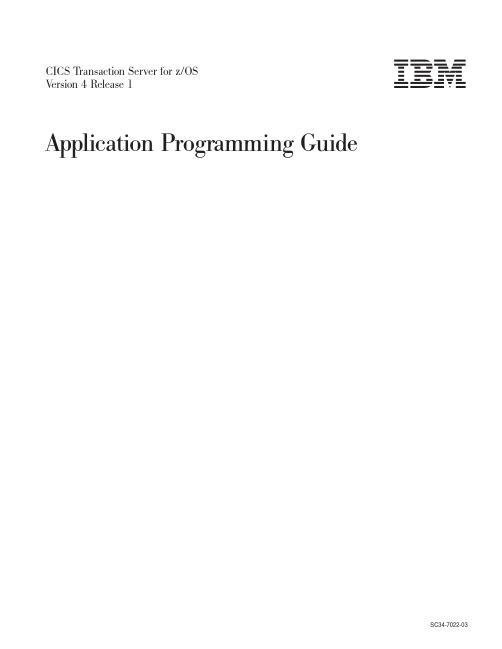
Dynamic invocation of the separate translator . . 78 Using a CICS translator . . . . . . . . . . 79 Defining translator options . . . . . . . . . 81
Translator options . . . . . . . . . . . 81 Translator options table . . . . . . . . . 91 Using COPY statements . . . . . . . . . . 93 The CICS-supplied interface modules. . . . . . 93 The EXEC interface modules . . . . . . . 93 The CPI Communications interface module. . . 93 The SAA Resource Recovery interface module . . 94 Using the EXEC interface modules . . . . . . 94 COBOL. . . . . . . . . . . . . . . 95 PL/I. . . . . . . . . . . . . . . . 95 C and C++ . . . . . . . . . . . . . 96 Assembler language . . . . . . . . . . 96 EXAMPLE Assembler language PROGRAM using LEASM . . . . . . . . . . . . 96
CIC消息中间件V1.0.0_VASD_APD用户使用手册
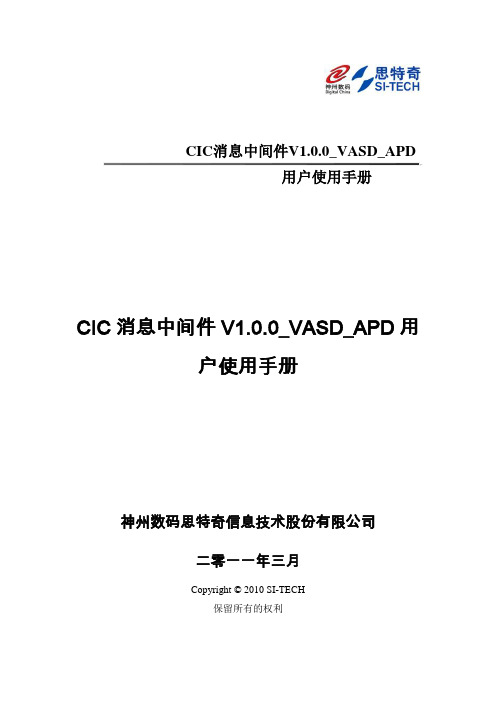
CIC消息中间件V1.0.0_VASD_APD用户使用手册神州数码思特奇信息技术股份有限公司二零一一年三月Copyright © 2010 SI-TECH保留所有的权利北京神州数码思特奇信息技术股份有限公司编写地址:中国北京海淀区上地九街9号数码科技广场二层SI-TECH Information Technology Ltd.版权声明本使用手册版权由北京神州数码思特奇信息技术股份有限公司所有,作为XX系统的组成部分。
未经北京神州数码思特奇信息技术股份有限公司的许可和授权,任何机构及人员不得将本手册及本使用手册包含的任何文字、内容及图片以任何理由,任何方式或手段(电子的或机械的)进行复制或传播。
© 北京神州数码思特奇信息技术股份有限公司版权所有保留所有权利2010年9月本使用手册内容若有变动,恕不另行通知。
本手册可能涉及北京神州数码思特奇信息技术股份有限公司的专利(或正在申请的专利)、注册商标(或正在注册的商标)、版权或其它知识产权,除非得到北京神州数码思特奇信息技术股份有限公司的明确书面许可协议,本手册不授予使用这些专利(或正在申请的专利)、注册商标(或正在注册的商标)、版权或其它知识产权的任何许可协议。
本手册提及的其它产品和公司名称均可能是各自所有者的商标。
目录1.引言 (8)1.1.编写目的 (8)1.2.项目背景 (8)2.系统介绍 (9)2.1.系统目标 (9)2.1.1.远景目标 (9)2.1.2.近期目标 (9)2.2.系统功能 (9)2.3.系统性能 (10)2.4.系统组成 (10)2.4.1.应用架构 (10)2.4.2.功能组成 (11)2.4.3.页面构成 (12)3.系统需求 (13)3.1.硬件需求 (13)3.2.软件需求 (13)4.系统登录模块使用说明 (15)4.1.系统登录 (15)4.1.1.功能简介 (15)4.1.2.操作说明 (15)4.1.3.注意事项 (16)4.2.系统登录首界面 (16)4.2.1.功能简介 (16)4.2.2.操作说明 (16)4.2.3.注意事项 (16)5.业务配置模块使用说明 (17)5.1.下行业务配置 (17)5.1.1.功能简介 (17)5.1.2.操作说明 (17)5.1.3.注意事项 (18)5.2.上行业务配置 (18)5.2.1.功能简介 (18)5.2.2.操作说明 (18)5.2.3.注意事项 (20)6.接入配置模块使用说明 (21)6.1.网关配置 (21)6.1.1.功能简介 (21)6.1.2.操作说明 (21)6.1.3.注意事项 (22)6.2.第三方配置 (22)6.2.1.功能简介 (22)6.2.2.操作说明 (22)6.2.3.注意事项 (25)7.参数配置模块使用说明 (26)7.1.参数配置 (26)7.1.1.功能简介 (26)7.1.2.操作说明 (26)7.1.3.注意事项 (27)8.路由配置模块使用说明 (28)8.1.路由配置 (28)8.1.1.功能简介 (28)8.1.2.操作说明 (28)8.1.3.注意事项 (29)9.工号管理配置模块使用说明 (30)9.1.账号管理 (30)9.1.1.功能简介 (30)9.1.2.操作说明 (30)9.1.3.注意事项 (31)9.2.角色管理 (32)9.2.1.功能简介 (32)9.2.2.操作说明 (32)9.2.3.注意事项 (33)10.日志查询模块使用说明 (34)10.1.短信下行日志 (34)10.1.1.功能简介 (34)10.1.2.操作说明 (34)10.1.3.注意事项 (35)10.2.短信上行日志 (35)10.2.1.功能简介 (35)10.2.2.操作说明 (36)10.2.3.注意事项 (37)10.3.彩信下行日志 (37)10.3.1.功能简介 (37)10.3.2.操作说明 (37)10.3.3.注意事项 (39)10.4.彩信上行日志 (39)10.4.1.功能简介 (39)10.4.2.操作说明 (39)10.4.3.注意事项 (41)11.监控告警模块使用说明 (42)11.1.阈值设定 (42)11.1.1.功能简介 (42)11.1.2.操作说明 (42)11.1.3.注意事项 (42)11.2.告警信息 (42)11.2.1.功能简介 (42)11.2.2.操作说明 (43)11.2.3.注意事项 (43)12.界面维护模块使用说明 (44)12.1.维护登陆 (44)12.1.1.功能简介 (44)12.1.2.操作说明 (44)12.1.3.注意事项 (45)13.常见问题 (46)附录:缩略语 (47)1.引言1.1. 编写目的本文档的编写目的以及预期读者。
CICS概述及命令-文档资料
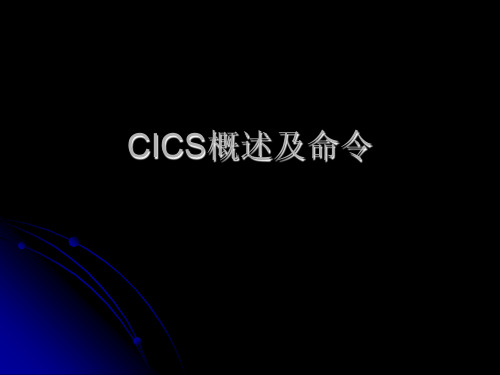
CICS概述
CICS/VS是在操作系统(OS)控制下的一个分区中作为 一个主程序运行,而若干联机应用程序是在CICS控 制下运行。
OS
VSE/POWER分区 DB CICS 分区 终端
应用 1
应用 2
应用 N
终端
其它分区
CICS概述
CICS提供以下服务: 一致性的应用编程接口(API) 透明访问操作系统的功能 系统管理的辅助工具(由很多小模块组成) 特点: (1)具有商务级事务管理器所要求的整合性、可恢复性、安全性和可用性 (2)提供跨平台的API,可移植性好 (3)具有跨系统通信ISC(InterSystem Communication)能力 产品: CICS/VSE CICS/MVS CICS/400 CICS/6000 CICS/OS2 CICS FOR NT
批处理
概念:在用户不直接干预的条件下,计算机系统对一定批量 的原始材料在规定的时间进行例行处理的过程。 从程序设计的意义上,批处理程序又有以下的特点: 1.所有必须的I/O区和工作区都应在程序中给出定义。 2.由程序读入有关部门的输入数据。 3.程序直接想操作系统发出I/O指令。 4.输入数据必须在处理开始前准备就绪(包括录入、校 验等过程),在处理是顺序读入。输入数据具有可控制批量、 可预计规模、顺序排列的物理特点,因而处理进程意识可跟 踪的。 5.出现故障时,处理可重新进行,或从故障点继续向后处理。
工作机制——“TRANSACTION标识TRANSACTIONTASK 应用程序”。
2、MULTITASKING——多重任务功能
CICS对同一区域中同时运行的许多TASK实施控制,采取的控制技术是任务开 关技术(TASK SWITCHING),根据TASK的优先权分配资源。
中间件维护和操作手册
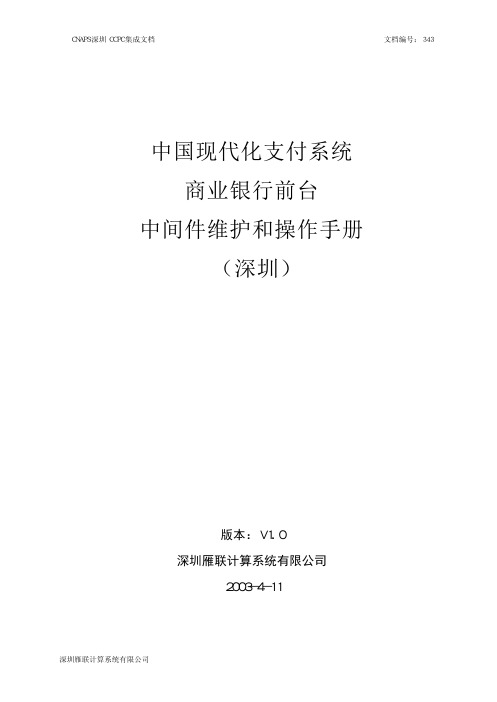
修改记录 修改次数 修改内容
修改时间
备注
版本 编者 审核 批准
日期
职位 日期 职位 日期
深圳雁联计算系统有限公司
CNAPS 深圳 CCPC 集成文档 文档编号:343
目录
1. CICS CLIENT 与 SERVER 端连接的配置方法........................................................... 1 2. CICS CLIENT 验收检查的常用操作............................................................................... 2 3. CICS CLIENT 日常维护................................................................................................... 3
CNAPS 深圳 CCPC 集成文档 文档编号:343
中国现代化支付系统 商业银行前台
中间件维护和操作手册 (深圳)
版本:V1.0 深圳雁联计算系统有限公司
2003-4-11
深圳雁联计算系统有限公司
CNAPS 深圳 CCPC 集成文档 文档编号:343
--
内容摘要
本手册用于中国现代支付系统 MBFE 节点的中间件维护和操作.
参考文档
《CICS Administration reference》、 http://www.ibm.com.cn 相关 FAQ
深圳雁联计算系统有限公司
CNAPS 深圳 CCPC 集成文档 文档编号:33
1. CICS Client 与 Server 端连接的配置方法
第2章_CICS系统管理基础--CICS 技术文档02

CICS 技术文档第二章CICS系统管理基础本章将向大家介绍一些CICS系统管理的基础知识。
主要内容为CICS日常管理工作,如CICS中常用资源的定义、维护,CICS系统安全设置,CICS的启动与停止,创建新的CICS区域的方法,CICS 系统的互联等。
2.1 CICS的日常管理CICS安装完成后就要投入使用了。
在使用过程中间就需要不间断的对CICS进行管理维护。
这些管理维护绝大部分可以使用CICS附带的事务来交互式的完成,有些管理工作也可以通过TSO下编写JCL调用CICS附带的工具程序来完成,如CICS系统日志的打印分析,CICS倾印数据(DUMP)的打印分析等。
那么CICS附带了哪些常见的事务呢?这些事务又如何使用呢?2.1.1 CICS提供的事务CICS提供了一组事务供我们对CICS进行操作和管理。
下面简单的介绍几个常用的事务,这些事务有时候也被称为CICS命令。
1).签到(Sign-on)和退出(Sign-off)CESN签到命令,用于登录CICS系统,只有在CICS安全保护启动的情况下才能使用。
在图2.1中输入正确的用户名和密码,然后执行就可以登录进入CICS了。
图2.1 CESN登录界面登录成功后,CICS提示:DFHCE3549 Sign-on is complete (Language ENU)。
该事务也提供了一个应用编程接口命令,可以在程序里使用:EXEC CICS SIGN-ONCESF签出命令,用于将当前登录的账号注销,返回CICS登录界面或退出CICS系统,返回z/OS 登录界面,CICS安全保护关闭的情况下也可以使用不带参数CESF就是将当前登录的账号注销,提示:DFHCE3590 Sign-off is complete。
此时用户还在CICS系统中,但身份是CICS初始化时指定的默认用户,一般为CICSUSER。
而下面带参数的CESF 命令则能退出CICS系统并返回z/OS登录界面:CESF LOGOFFCESF GOODCESF GOODNIGHT2).操作和控制终端CEOT 终端信息查询CEMT 主控终端事务(Mast Terminal)用于执行CICS系统查询、设置和操作任务,主要有三个选项:CEMT INQUIRE 查询系统信息PERFORM 执行系统操作命令SET 设置系统参数DISCARD 删除系统在用资源信息如下面命令可以查询当前CICS区域内正在运行的任务的信息,并且可以对这些任务进行操作,如取消、中止某些任务。
CICS客户信息控制系统教程说明书

About the T utorialCICS stands for Customer Information Control System. CICS was developed in 1968 by IBM. CICS allows users to develop and execute online application in an MVS environment. CICS has become the most commonly used server for Internet applications.CICS is a transaction processing system which is also called as Online Transaction Processing (OLTP) Software. CICS is a data communication system that can support a network containing hundreds of terminals.AudienceThis tutorial is designed for software programmers who would like to understand the concepts of CICS starting from scratch. This tutorial will give you enough understanding on CICS from where you can take yourself to higher levels of expertise.PrerequisitesBefore proceeding with this tutorial, you should have a basic understanding of COBOL programming. A basic knowledge of MVS and TSO/ISPF subsystem will help you grasp the concepts of CICS better.Disclaimer & CopyrightCopyright 2015 by Tutorials Point (I) Pvt. Ltd.All the content and graphics published in this e-book are the property of Tutorials Point (I) Pvt. Ltd. The user of this e-book is prohibited to reuse, retain, copy, distribute, or republish any contents or a part of contents of this e-book in any manner without written consent of the publisher. We strive to update the contents of our website and tutorials as timely and as precisely as possible, however, the contents may contain inaccuracies or errors. Tutorials Point (I) Pvt. Ltd. provides no guarantee regarding the accuracy, timeliness, or completeness of our website or its contents including this tutorial. If you discover any errors on our website or in this tutorial, please notify us at **************************iT able of ContentsAbout the Tutorial (i)Audience (i)Prerequisites (i)Disclaimer & Copyright (i)Table of Contents .................................................................................................................................. i i 1.CICS – OVERVIEW (1)Functions of CICS (1)Features of CICS (2)2.CICS – ENVIRONMENT (3)CICS Environment (3)Data Communication Services (4)Data Handling Services (4)Application Programming Services (4)Monitoring Services (5)3.CICS – BASIC TERMS (6)IBM 3270 Terminal (6)CRT Monitor (6)Keyboard (7)Transaction (8)Task (8)LUW (9)Application (9)4.CICS – NUCLEUS (10)Control Programs (10)TCP (10)KCP (10)iiFCP (10)SCP (11)Control Tables (11)TCT (11)PCT (11)PPT (11)FCT (12)Transaction (12)Transaction Life Cycle (13)5.CICS – TRANSACTIONS (16)CESN (16)CEDA (16)CEMT (16)CECI (17)CEDF (18)CMAC (18)CESF (18)CEBR (18)CICS Concepts (19)Multitasking (19)Multi-threading (19)Re-entrancy (19)Quasi-reentrancy (19)6.CICS – COBOL BASICS (20)CICS Program (20)Program Compilation (22)7.CICS – BMS (24)Formatted Screen (24)BMS Basic Terms (25)Map (25)iiiBMS Macros (25)8.CICS – MAP (31)Physical Map (31)Symbolic Map (32)Skipper and Stopper Field (32)Skipper Field (32)Stopper Field (33)Attribute Byte (33)Modified Data Tag (34)Send Map (34)Receive Map (36)Mapset Execution (36)9.CICS – INTERFACE BLOCK (38)Restricted COBOL Verbs (38)Execute Interface Block (38)EIB Fields (39)CICS Programs Classification (39)Non Conversion Programs (39)Conversion Program (40)10.CICS – PSEUDO PROGRAMMING (43)Pseudo-Conversion Program (43)Pseudo Conversion Techniques (44)COMMAREA (44)DFHCOMMAREA (45)Pseudo Code (45)Advantages of Pseudo Conversion (48)Return Statements (48)Return-1 (48)iv11.CICS – AID KEYS (49)Validating AID keys (49)DFHAID (49)Cursor Positioning (51)Dynamically Modifying Attributes (51)12.CICS – FILE HANDLING (54)Random Access (54)Read (54)Read Command Options (56)Read Command Exceptions (57)Write (57)Write Command Exceptions (58)Rewrite (59)Rewrite Command Exceptions (60)Delete (60)Delete Command Exceptions (62)Sequential Access (62)STARTBR (62)READNEXT / READPREV (63)RESETBR (63)ENDBR (64)13.CICS – ERROR HANDLING (65)CICS Errors (65)Error Handling Commands (65)Handle Condition (65)Handle Abend (66)Abend (67)vNohandle (68)14.CICS – CONTROL OPERATIONS (70)Program Logical Levels (70)XCTL (71)Link (72)Load (72)Release (73)Return (73)Interval Control Operations (73)ASKTIME (73)FORMATTIME (73)15.CICS – TEMPORARY STORAGE (75)COMMAREA (75)Common Work Area (75)Transaction Work Area (75)Temporary Storage Queue (75)WRITEQ TS (76)READQ TS (76)DELETEQ TS (77)Transient Data Queue (77)WRITEQ TD (77)READQ TD (77)DELETEQ TD (78)16.CICS – INTERCOMMUNICATION (79)Benefits of Intercommunication (79)viIntercommunication Methods (80)17.CICS – STATUS CODES (81)18.CICS – INTERVIEW QUESTIONS (82)viiCICS 8CICS is a DB/DC system which is used in online applications. CICS was developed because batch operating system can execute only batch programs. CICS programs can be written in COBOL, C, C++, Java, etc. These days, users want information within seconds and in real time. To provide such quick service, we need a system which can process information online. CICS allows users to communicate with the back-end system to get the desired information. Examples of online programs include online banking system, flight reservation, etc. Following image shows the components of CICS and how they are inter-related:Functions of CICSThe main functions performed by CICS in an application are as follows:∙ CICS manages requests from concurrent users in an application.∙ Although, multiple users are working on CICS system but it gives a feel to userthat he is the single user only.∙ CICS gives the access to data files for reading or updating them in anapplication.1.CICS9Features of CICSThe features of CICS are as follows:∙CICS is an operating system in itself, as it manages its own processor storage, has its own task manager which handles execution of multiple programs, and provides its own file management functions.∙CICS provides online environment in batch operating system. Jobs submitted are executed immediately.∙CICS is a generalized transaction processing interface.∙It is possible to have two or more CICS regions at the same time, as CICS runs as a batch job in the operating system at the back-end.CICS 10CICS itself acts as an operating system. Its job is to provide an environment for online execution of application programs. CICS runs in one region or partition or address space. CICS handles scheduling for programs running under it. CICS runs as a batch job and we can view it in the spool by issuing the command PREFIX CICS*. There are five major services which are provided by CICS. All these services together perform a task.CICS EnvironmentFollowing are the services which we will be discussing in detail step by step:∙ System Services∙ Data Communication Services∙ Data Handling Services∙ Application Programming Services∙ Monitoring Services∙ System ServicesCICS maintains control functions to manage the allocation or de-allocation of resources within the system which are as follows:∙ Task Control – Task control provides task scheduling and multitaskingfeatures. It takes care of the status of all CICS tasks. Task Control allocates the processor time among concurrent CICS tasks. This is called multitasking . CICS tries to prioritize the response time to the most important task.∙ Program Control – Program Control manages loading and releasing ofapplication programs. As soon as a task begins, it becomes necessary to associate the task with the appropriate application program. Although many tasks may need to use the same application program, CICS loads only one copy of the code into memory. Each task threads its way through this code independently, so many users can all be running transactions that are concurrently using the same physical copy of an application program.2.11∙Storage Control– Storage Control manages acquiring and releasing of main storage. Storage control acquires, controls, and frees dynamic storage.Dynamic storage is used for input/output areas, programs, etc.∙Interval Control– Interval Control offers timer services.Data Communication ServicesData Communication Services interface with telecommunication access methods such as BTAM, VTAM, and TCAM for handling data communication requests from application programs.∙CICS releases application programs from the burden of dealing with terminal hardware issues through the use of Basic Mapping Support (BMS).∙CICS provides Multi Region Operation (MRO) through which more than one CICS region in the same system can communicate.∙CICS provides Inter System Communication (ISC) through which a CICS region in a system can communicate with the CICS region on another system. Data Handling ServicesData Handling Services interface with data access methods such as BDAM, VSAM, etc.∙CICS facilitates servicing of data handling requests from application programs.CICS provides application programmers a set of commands for dealing with data set and database access and related operations.∙Data Handling Services interfaces with database access methods such as IMS/DB, DB2, etc. and facilitate servicing of database requests from application programs.∙CICS facilitates management of data integrity by control of simultaneous record updates, protection of data as task ABENDs and protection of data at system failures.12Application Programming ServicesApplication Programming Services interface with application programs. The application programming services of CICS provide features such as command level translation, CEDF (the debug facility) and CECI (the command interpreter facility). We will be discussing more in detail in upcoming modules.Monitoring ServicesMonitoring Services monitor various events within CICS address space. It provides series of statistical information that can be used for system tuning.CICS 13We must have knowledge of the basic terms used in CICS to get a better understanding of how it works. Application programs use CICS for communication with remote and local terminals and subsystems.IBM 3270 T erminalThe 3270 Information Display System is a family of display and printer terminals. 3270 terminals were being used to connect to the mainframe via IBM controllers. Today, 3270 emulation software is available which means that even normal PCs can be used as 3270 terminals. 3270 terminals are dumb terminals and do not do any processing themselves. All processing needs to be done by the application program. IBM terminals consist of the following components:CRT MonitorThe CRT monitor displays the output or the input fields of the application program. A screenshot of a 3278 Model of CRT monitor is shown below. It has the following characteristics:∙It is capable of displaying 1920 characters. ∙Each of these 1920 character positions is individually addressable. ∙A COBOL application program can send data to all the positions on the screen. ∙ The display characteristics like intensity, protected, non-protected of the fieldcan be set using BMS which we will be discussing in detail in upcoming modules.3.14KeyboardIBM keyboard keys are divided into following two categories:∙Non-AID Keys– All other keys for alphabets, numeric, punctuation etc. are Non-Aid keys. When the user types text or numbers using non-aid keys, CICS will not even know if the user is typing anything or not.∙AID Keys– AID keys are known as Attention Identifier Keys. CICS can detect only AID keys. After typing all the input, only when the user presses one of the AID keys, CICS takes control. AID Keys : ENTER, PF1 to PF24, PA1 to PA3, CLEAR. AID keys are further divided into two categories:o PF Keys– PF keys are known as function keys. PF keys allow transfer of data from terminal to CICS. PF Keys are ENTER and PF1 to PF24.o PA Keys– PA keys are known as Program Access keys. PA keys do not allow transfer of data between terminal and CICS. PA Keys are PA1 to PA3and CLEAR.15TransactionA CICS program is invoked through a transaction. A CICS transaction is a collection of logically related programs in an application. The whole application could be logically divided into several transactions.∙Transaction identifiers which are 1 to 4 characters long are used to identify the transactions which the users want to do.∙ A programmer links one program to the transaction identifier which is used to invoke all the application programs for that particular transaction.T askA Task is a unit of work which is specific to a user.∙Users invoke an application by using one of the transaction identifiers. CICS looks up for the transaction identifier to find out which program to invoke first to do the work requested. It creates a task to do the work, and transfers control to the mentioned program.∙ A transaction can be completed through several tasks.∙ A task can receive data from and send data to the terminal that started it. It can read and write files and can start other tasks also.16Task vs. TransactionThe difference between a transaction and a task is that several users can invoke a transaction but each user initiates his own task.LUWLUW stands for Logical Unit of Work. LUW states that a piece of work should be done completely or not done at all. A task can contain several Logical Unit of Works in CICS. We will discuss more about it in upcoming modules.ApplicationAn application is a series of logically grouped programs to form several transactions which is used to complete a specific task for the end-user.CICS 17The five CICS system components described earlier are a convenient grouping of CICS system programs, each of which performs its own specialized functions. The core of CICS known as the CICS Nucleus which consists of IBM-supplied CICS Control Programs and Control Tables.Control ProgramsCICS nucleus is constructed by the control programs and corresponding control tables. It provides unique advantages. It makes the CICS system highly flexible and thus easy to maintain. Following are the important control programs of CICS: TCPTCP is known as Terminal Control Program.∙TCP is used to receive messages from the terminal. ∙It maintains hardware communication requirements. ∙ It requests CICS to initiate the tasks.KCPKCP is known as Task Control Program.∙ KCP is used to simultaneously control the execution of tasks and its relatedproperties.∙It handles all the issues related to multi-tasking. PCPPCP is known as Program Control Program.∙PCP is used to locate and load programs for execution. ∙ It transfers the control between programs and in the end, it returns the controlback to the CICS.4.18FCP is known as File Control Program.∙FCP is used to provide application programs with services like read, insert, update or delete records in a file.∙It keeps exclusive control over the records in order to maintain data integrity during record updates.SCPSCP is known as Storage Control Program. It is used to control allocation and de-allocation of storage within a CICS region.Control T ablesCICS consists of IBM-supplied CICS control programs and tables. These tables need to be updated accordingly with the application information for successful execution of CICS application programs. Following are the important Control Tables:TCTTCT is known as Terminal Control Table.∙When we login to a CICS terminal, an entry is made in the TCT table.∙TCT contains the terminal ID's that are connected to current CICS region.∙Terminal Control Program along with terminal control table recognize the incoming data from the terminal.PCTPCT is known as Program Control Table.∙It contains the Transaction IDs (TRANSID) and the corresponding program names or program IDs.∙TRANSID is unique in PCT table.19PPT is known as Processing Program Table. PPT contains Program name or Mapset name, Task Use Counter, Language, Size, Main storage address, Load library address, etc.∙Program or Mapset name is unique in a PPT table.∙CICS receives the transaction and a corresponding program name is allocated to the transaction from the PCT. It checks if the program is loaded or not. If it is loaded, then the task use counter is increased by 1. If the program is not loaded, then the program is first loaded and the task use counter is set to 1.It gets the load library address from the PPT table.FCTFCT is known as File Control Table.∙It contains File names, File type, record length, etc.∙All the files used in a CICS program must be declared in FCT and they are opened and closed by CICS itself.TransactionWhen a transaction identifier TP02 is entered on the CICS terminal, first it checks if there is a program associated with this Transaction identifier in the PCT table. If it finds one, then it checks in the PPT table to find the location of the Program to execute it.If the program is already available in the memory, it starts executing that particular program; if not, it loads the program to the memory from the secondary storage and then starts executing it.2021Transaction Life CycleThe transaction life cycle has the following steps:Step 1The terminal operator initiates the transaction by typing a 1 to 4-character transaction-id and pressing the ENTER key.Step 2The TCP periodically checks all the terminals for input. When a message is received, it does the following:∙Instructs the SCP to create a TIOA. ∙Places the message in the TIOA.22End of ebook previewIf you liked what you saw…Buy it from our store @ https://。
CICS性能分析器和相关工具的概述说明书
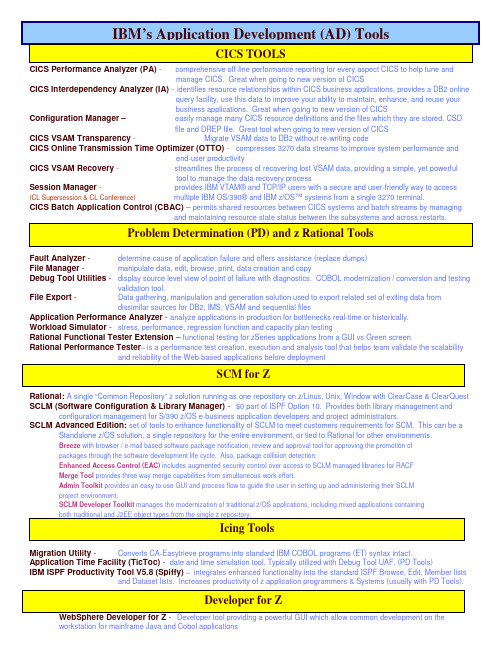
CICS Performance Analyzer (PA) - comprehensive off-line performance reporting for every aspect CICS to help tune andmanage CICS. Great when going to new version of CICS CICS Interdependency Analyzer (IA)- identifies resource relationships within CICS business applications, provides a DB2 onlinequery facility, use this data to improve your ability to maintain, enhance, and reuse yourbusiness applications. Great when going to new version of CICSConfiguration Manager – easily manage many CICS resource definitions and the files which they are stored. CSDfile and DREP file. Great tool when going to new version of CICS CICS VSAM Transparency - Migrate VSAM data to DB2 without re-writing code CICS Online Transmission Time Optimizer (OTTO) - compresses 3270 data streams to improve system performance andend-user productivity CICS VSAM Recovery - streamlines the process of recovering lost VSAM data, providing a simple, yet powerfultool to manage the data recovery process Session Manager - provides IBM VTAM® and TCP/IP users with a secure and user-friendly way to access(CL Supersession & CL Conference) multiple IBM OS/390® and IBM z/OS™ systems from a single 3270 terminal. CICS Batch Application Control (CBAC) – permits shared resources between CICS systems and batch streams by managingFault Analyzer - determine cause of application failure and offers assistance (replace dumps) File Manager - manipulate data, edit, browse, print, data creation and copy Debug Tool Utilities - display source level view of point of failure with diagnostics. COBOL modernization / conversion and testingvalidation tool. File Export - Data gathering, manipulation and generation solution used to export related set of exiting data fromdissimilar sources for DB2, IMS, VSAM and sequential files Application Performance Analyzer - analyze applications in production for bottlenecks real-time or historically. Workload Simulator - stress, performance, regression function and capacity plan testing Rational Functional Tester Extension – functional testing for zSeries applications from a GUI vs Green screen. Rational Performance Tester – is a performance test creation, execution and analysis tool that helps team validate the scalabilityRational: A single “Common Repository” z solution running as one repository on z/Linus, Unix, Window with ClearCase & ClearQuest SCLM (Software Configuration & Library Manager) - $0 part of ISPF Option 10. Provides both library management andconfiguration management for S/390 z/OS e-business application developers and project administrators. SCLM Advanced Edition: set of tools to enhance functionality of SCLM to meet customers requirements for SCM. This can be a Standalone z/OS solution, a single repository for the entire environment, or tied to Rational for other environments. Breeze with browser / e-mail based software package notification, review and approval tool for approving the promotion ofpackages through the software development life cycle. Also, package collision detection.Enhanced Access Control (EAC) includes augmented security control over access to SCLM managed libraries for RACFMerge Tool provides three way merge capabilities from simultaneous work effort.Admin Toolkit provides an easy to use GUI and process flow to guide the user in setting up and administering their SCLMproject environment.SCLM Developer Toolkit manages the modernization of traditional z/OS applications, including mixed applications containing Migration Utility - Converts CA-Easytrieve programs into standard IBM COBOL programs (ET) syntax intact. Application Time Facility (TicToc) - date and time simulation tool. Typically utilized with Debug Tool UAF. (PD Tools) IBM ISPF Productivity Tool V5.8 (Spiffy) – integrates enhanced functionality into the standard ISPF Browse, Edit, Member lists and Dataset lists. Increases productivity of z application programmers & Systems (usually with PD Tools). workstation for mainframe Java and Cobol applications。
CICS Transaction Server for OS 390说明书

The CICS libraryCICS Transaction Server for OS/390CICS Transaction Server for OS/390:Planning for Installation GC33-1789CICS Transaction Server for OS/390Release Guide GC34-5352CICS Transaction Server for OS/390Migration Guide GC34-5353CICS Transaction Server for OS/390Installation Guide GC33-1681CICS Transaction Server for OS/390Program Directory GI10-2506CICS Transaction Server for OS/390Licensed Program Specification GC33-1707CICS books for CICS Transaction Server for OS/390GeneralCICS Master Index SC33-1704CICS User’s Handbook SX33-6104CICS Transaction Server for OS/390Glossary(softcopy only)GC33-1705AdministrationCICS System Definition Guide SC33-1682CICS Customization Guide SC33-1683CICS Resource Definition Guide SC33-1684CICS Operations and Utilities Guide SC33-1685CICS Supplied Transactions SC33-1686ProgrammingCICS Application Programming Guide SC33-1687CICS Application Programming Reference SC33-1688CICS System Programming Reference SC33-1689CICS Front End Programming Interface User’s Guide SC33-1692CICS C++OO Class Libraries SC34-5455CICS Distributed Transaction Programming Guide SC33-1691CICS Business Transaction Services SC34-5268DiagnosisCICS Problem Determination Guide GC33-1693CICS Messages and Codes GC33-1694CICS Diagnosis Reference LY33-6088 (licensed)CICS Data Areas LY33-6089 (licensed)CICS Trace Entries SC34-5446CICS Supplementary Data Areas LY33-6090 (licensed) CommunicationCICS Intercommunication Guide SC33-1695CICS Family:Interproduct Communication SC33-0824CICS Family:Communicating from CICS on System/390SC33-1697CICS External Interfaces Guide SC33-1944CICS Internet Guide SC34-5445Special topicsCICS Recovery and Restart Guide SC33-1698CICS Performance Guide SC33-1699 (to be updated)CICS IMS Database Control Guide SC33-1700CICS RACF Security Guide SC33-1701CICS Shared Data Tables Guide SC33-1702CICS Transaction Affinities Utility Guide SC33-1777CICS DB2Guide SC33-1939CICSPlex SM books for CICS Transaction Server for OS/390GeneralCICSPlex SM Master Index SC33-1812CICSPlex SM Concepts and Planning GC33-0786CICSPlex SM User Interface Guide SC33-0788CICSPlex SM View Commands Reference Summary SX33-6099 Administration and ManagementCICSPlex SM Administration SC34-5401CICSPlex SM Operations Views Reference SC33-0789CICSPlex SM Monitor Views Reference SC34-5402CICSPlex SM Managing Workloads SC33-1807CICSPlex SM Managing Resource Usage SC33-1808CICSPlex SM Managing Business Applications SC33-1809 ProgrammingCICSPlex SM Application Programming Guide SC34-5457CICSPlex SM Application Programming Reference SC34-5458 DiagnosisCICSPlex SM Resource Tables Reference SC33-1220CICSPlex SM Messages and Codes GC33-0790CICSPlex SM Problem Determination GC33-0791 If you have any questions about the CICS Transaction Server for OS/390library,see CICS Transaction Server for OS/390:Planning for Installation which discussesboth hardcopy and softcopy books and the ways that the books can be ordered.。
IBM zSecure CICS TS 5.5 货币支持文档更新说明书
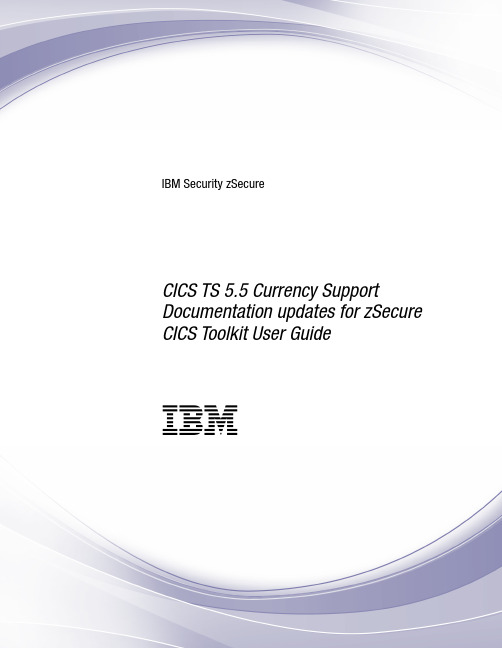
|
data set named similarly to CICSTS54.XDFHINST. An example is provided in
|
SCQTSAMP member CQTJSRT.
|
► Adapt and submit CQTJSRT.
|
It is possible to automatically start and stop the CICS Toolkit sub-tasks on CICS
|
DFHPLT TYPE=ENTRY,PROGRAM=CQTPDTCH
|
An example is provided in member CQTPLTT2.
|
v If you are installing into a CICS TS 5.4 or older release, you must translate the
|
example is provided in SCQTSAMP member CQTSRTT1.
|
v The SRT must be translated with the CICS table update procedure that is in use
|
at your installation. Typically, the procedure is called DFHAUPLE, and it is in a
2 IBM Security zSecure: CICS TS 5.5 Currency Support Documentation updates for zSecure CICS Toolkit User Guide
zSecure CICS Toolkit User Guide 3
CICS维护培训
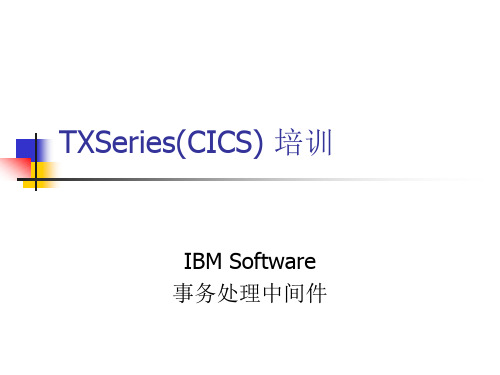
IBM Software Group
RDBMS Applications
CICS
XA 2 Phase
CONNECTION CICS XAD
XA 1 Phase
CICS XAD
NON-XA
NO CONNECTION MANAGEMENT SQL CONNECT BUSINESS LOGIC SQL FETCH/UPDATE
APPLICATION LOGIC
BUSINESS LOGIC SQL FETCH/UPDATE (NO CONNECT DISCONNECT COMMIT ROLLBACK) CICS SYNCPOINT IMPLICIT CICS COORDINATION PREPARE: COMMIT/ABORT PERSISTENT CONNECTION
(not addressable)
Region Pool ? RCA(CSA) & TCA ? Internal structures & tables
(read/write)
Task Shared Pool ? CWA, TCTUA, BMS maps ? user tables, getmain shared
BUSINESS LOGIC SQL FETCH/UPDATE
(COMMIT ?) (ROLLBACK ?) CICS SYNCPOINT IMPLICIT CICS COORDINATION COMMIT/ROLLBACK PERSISTENT CONNECTION
SYNCPOINT
SQL COMMIT SQL ROLLBACK SQL DISCONNECT NO CICS COORDINATION UNKNOWN STATE ON ABEND NO CONNECTION MANAGEMENT
CICS 事务服务器 for OS 390 V1.3 新特性说明书
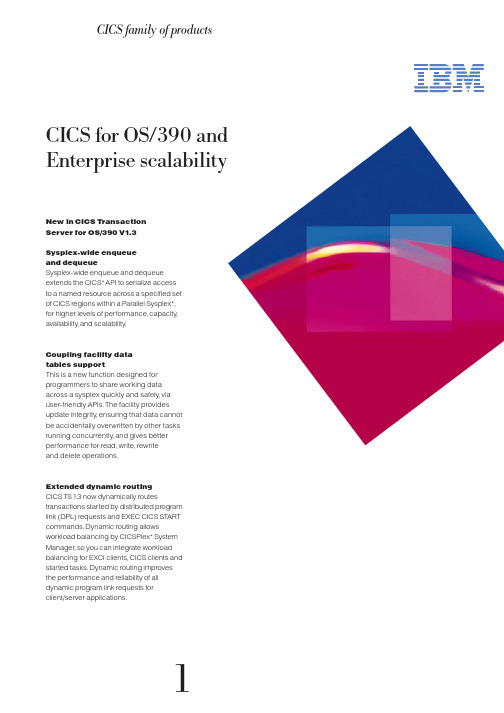
CICS family of productsNew in CICS Transaction Server for OS/390 V1.3Sysplex-wide enqueue and dequeueSysplex-wide enqueue and dequeue extends the CICS* API to serialize access to a named resource across a specified set of CICS regions within a Parallel Sysplex*,for higher levels of performance,capacity ,availability ,and scalability .Coupling facility data tables supportThis is a new function designed for programmers to share working data across a sysplex quickly and safely ,via user-friendly APIs.The facility provides update integrity ,ensuring that data cannot be accidentally overwritten by other tasks running concurrently ,and gives better performance for read,write,rewrite and delete operations.Extended dynamic routing CICS TS 1.3 now dynamically routestransactions started by distributed program link (DPL) requests and EXEC CICS ST ART commands.Dynamic routing allowsworkload balancing by CICSPlex* System Manager ,so you can integrate workload balancing for EXCI clients,CICS clients and started tasks.Dynamic routing improves the performance and reliability of all dynamic program link requests for client/server applications.CICS for OS/390 and Enterprise scalabilityLarge-scale capabilitiesCICS has always offered total transac tion processing solutions that reflec t the best available technology of the time.Now ,it is able to exploit and complement the capabilities of Parallel Sysplex for large-scale processing with data sharing,systems management and availability features.The redundancy in the multipleprocessors of Parallel Sysplex,combined with workload management,means that it is possible to maintain high capacity and availability economically ,without needing to resort to dedicated standby machines.These Parallel Sysplex themes are expanded in CICS T ransaction Server.Not only does CICS include enhanced capabilities for availability and growth (see later sections),but it is also exceptionally cost-effective.Cost-effectivenessCICS has always been cost-effective because of innovations such assimplified packaging and installation,and its use of your existing applications and workstations when migrating to a networked environment.Now,in this release,dynamic routing for DPL and EXEC CICS START improves performance and reliability of all dynamic program link requests,giving even better price performance for distributed or client server application deployments whether running in a CICS domain or within mixed heterogeneous environments.Continuous availability A key benefit of Parallel Sysplex isenhanced availability ,achieved through the removal of single points of failure.MVS* workload management allocates resources to meet your own defined performance goals.CICS T ransaction Server has features that complement and build on theParallel Sysplex approach.It is possible to bypass points of failure at any of the three processing tiers: at the terminal,application,or data.Parallel SysplexOne of the oldest strategies for controlling large territories is divide and rule.Parallel Sysplex brings a dynamic new slant to this approach.By dividing up large-scale processing requirements between many processors,a flexible,manageable and cost-effective system is derived which gives almost unlimited availability and potential for growth.A Parallel Sysplex offers:•Maximum scalability ,giving easy growth of applications and users•High performance,from state-of-the-art technology•Cost-effectiveness,due to industry-standard components•Continuous availability ,with built-in redundancy .The IBM S/390* Parallel Sysplex uses multiple low-cost processors linked together to provide a uniquely scalable shared-data clustered server architecture.Individual S/390 nodes,which have a symmetric multiprocessor (SMP)architecture with up to 10 processors,may be connected via coupling links to a coupling facility ,to support clusters with very high MIPS.Enterprise data stored in DB2*,IMS-DB and VSAM may be shared by all nodes in a cluster.Working data held in CICS temporary storage and coupling facility data tables may also be shared by all nodes; CICS applications may execute on any node in the cluster with full access to all data.CICS applications may also execute on single node S/390 systems,without any dependency on clustering hardware.For example:•T erminal users can restart more easily through CICS support for the VTAM*generic resource ers are no longer associated with one CICS system,but can use others if one fails•Applications can be routed away from a failing application owning region (AOR) by the workload management functions,exploiting temporary storage (TS) data sharing,VSAM record-level sharing (RLS)and data sharing capabilities for IMS* and DB2•Data accessed through CICS VSAM RLS and CICS TS data sharing avoids dependence on file or queue owning regions (FOR and QOR),eliminating such regions as single points of failure.A new CICS log manager exploits the MVS logger and the coupling facility to simplify systems management by enhancing handling of the log media.The log manager supports the new VSAM RLS plus CICS user journals.The new CICS recovery manager works with the log manager,DB2 and IMS to resolve the status of in-flight tasks in afailed CICS region with less time and effort.System management features provided with CICS T ransaction Server build on the workload management available with MVS to manage CICS systems to your service class goals.Workload is balanced across AORs and,in the event of a failing region,CICS redistributes to ensure that availability and throughput are maximized.Unlimited growthGrowth has never been easier than with the Parallel Sysplex technologies and OS/390*.In fact,S/390 computers can provide the largest commercial computing capacity in the industry today .CICS T ransaction Server makes it straightforward to exploit the growth potential.For example,the CICS support for VTAM generic resource means that communications between distributed applications or multiple CICS systems become more flexible.That makes extending CICS systems even easier.A major advantage of Parallel Sysplex is the ability to grow in small incremental steps,due to the use of micro-processors.Growth can be achieved withoutinterruption to processing,and you gain the benefit as soon as the routing mechanism is aware of the additional resource.Growth in the enterprise brings growth in the Parallel Sysplex and CICS images.CICS systems management facilities help to maintain an efficient CICSPlex by signaling alerts as interaction between regions reaches preset levels.System responses can be automated,whilebuilt-in CICS workload balancing helps to achieve service goals and,by smoothing load peaks,keeps response times stable.Parallel Sysplex data sharingIn this release,CICS is adding support for sysplex-wide sharing of data tables (high performance in-memory files),Sysplex-wide enqueue and dequeue enabling sysplex-wide synchronization of applications,and a named counter server allowing applications to create sysplex-wide unique identifiers.Also provided is dynamic routing for transactions originating from CICS DPL and ST ART commands,enabling dynamic workload management of these transactions in common with the function already supported for transactions originating from 3270 terminals.Sysplex enqueue and dequeue enhances Parallel Syspleximplementations by providing better price/performance,capacity ,availability and scalability .T o take full advantage of workload balancing,it is helpful to identifyprogramming dependencies,or affinities,between transactions,which could constrain the workload manager.Identifying affinities is part of migrating to Parallel Sysplex,and is made easy with the CICS transaction affinities utility ,shipped with CICS T ransaction Server.Sysplex enqueue and dequeue provides the ability to eliminate the most significant remaining cause of inter-transaction affinity across CICS regions,by enabling greater exploitation of a Parallel Sysplex,and reducing the need to provide inter-transaction affinity rules to any dynamic routing mechanism.IBM United Kingdom Limited Hursley Park Winchester Hampshire SO212JN,UKT elephone: +44 1962 815000IBM Ireland Limited 2 Burlington Road Dublin 4T elephone: 1850 205 205The IBM home page can be found on the Internet at www and some more information on CICS can be found at www /cics UK company-wide registration to ISO9001.Certificate number FM 12587.IBM is a registered trademark of International Business Machines Corporation.*CICS,Parallel Sysplex,CICSPlex,S/390,DB2,MVS,VTAM,IMS,OS/390 and MVS/ESA are trademarks of International Business Machines Corporation.Other company ,product or service names may be trademarks or service marks of others.References in this publication to IBM products,programs or services do not imply that IBM intends to make these available in all countries in which IBM operates.Any reference to an IBM product,program or service is not intended to imply that only IBM's product,program or service may be used.Any functionally equivalent product,program or service may be used instead.IBM hardware products are manufactured from new parts,or new and used parts.In some cases,the hardware product may not be new and may have been previously installed.Regardless,our warranty terms apply .This publication is for general guidance only .Printed in England by Basingstoke Press (75) Limited,Basingstoke,Hampshire.©International Business Machines Corporation 1998.GC33-1180-01(09/98)Information for decision makers Hardware requirementsCICS T ransaction Server for OS/390 1.3 can exploit the parallel sysplex features of any IBM processor that supports MVS/ESA* SP V5.2 and has one or more coupling facilities.Other helpful information•T ry /cics/for the latest news of CICS on the Web•For more information on CICS T ransaction Server,look at CICS T ransaction Server for OS/390 planning for Installation GC34-5401•For help on migrating to CICS onParallel Sysplex,look at CICS Migration Guide,GC33-1571•For further help,contact your IBM Representative or dealer.。
IBMTXSeriesCICS管理1_OK
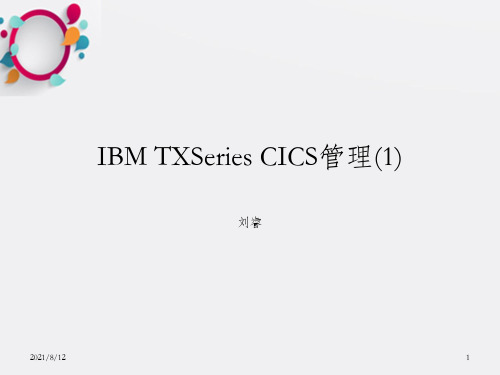
3816/0001 3816/0020 3816/0020 3332/0001 3816/0020 3816/0020 3816/0020 4024/0001 3332/0001 4024/0001 3740/0007 4088/0001 4076/0001 3740/0001 3264/0001 4076/0001 4076/0001 4076/0001 4076/0001 4076/0001 4076/0001 4076/0001 4076/0001 4076/0001 3332/0001 4076/0001 4076/0001 3816/0020
: 已将区域‘CICSNT01’配置为支持 Encina 结构化文件服务器(SFS)。 : 正在创建 CICS 进程‘cicsld’ : 正在创建 CICS 进程‘cicslm’ : 日志守护进程等待访问主日志文件 : 正在创建 CICS 进程‘cicsam’ : 正在创建 CICS 进程‘cicsrl’ : 正在创建 CICS 进程‘cicsic’ : 恢复管理器结束,带有主日志文件 : CICS 日志守护进程就绪 : 应用程序管理器正在启动 MinSever 个服务器 : 正在创建侦听器‘LI1’的 CICS 进程‘cicsip’ : 已启动应用程序服务器 101 : 已启动应用程序服务器 102 : 正在等待侦听器‘LI1’初始化 : CICS 侦听器‘LI1’进程‘cicsip’为‘127.0.0.1 [1435]’而启动 : CICS 初始化事务已启动 : 正在打开文件 ... : ...文件打开完成 : 正在处理瞬时数据队列 ... : 已处理瞬时数据队列! : 处理临时存储队列... : 临时存储队列已经处理完毕! : 根据异步处理请求来处理本地队列 ... : 本地队列已被处理 : 启动检查点 : CICS 初始化事务已结束 : 完成处理启动和关闭程序列表 : *** CICS 启动已完成 ***
CICSl路况快速检测车运行与维护

CICS多功能路况快速检测车的应用和运行于岗(陕西公路集团有限公司)摘要安全、舒适的行车需求给公路人提出了更高的工作要求,因此近几年来我们养管单位在精细化养护这方面做了不少功课。
公路状况检测评定是养护管理工作的重要环节,随着高新检测技术的应用和CICS多功能检测车的引进,使我省路况检测工作跻身全国前列,大大促进了我省公路养护管理工作的开展。
关键词路况检测车应用运行1.简介CICS多功能道路检测车是目前快速检测最准确的数据采集系统,能够在限速标志标明的情况下高速采集包括平整度、车辙、道路几何线性、路面病害、路产信息等道路指标。
且所有系统的技术指标均为最先进水平。
多功能道路测试车是一套模块化的数据采集平台,由一辆特别改装的汽车和各种数据采集子系统组成。
包括:道路几何参数测量系统、GPS全球定位系统、激光线扫描车辙测量系统、纵向断面平整度测量系统、计算机定标录像及测量平台、高精度道路几何系数测量系统、路面纹理测量系统、道路全景路况扫描、路面病害分类评级软件、路面摄像-全自动的裂缝探测机识别系统。
3】CICS多功能检测车外观2.检测指标内容多功能路况快速检测系统(CiCS)外业检测指标包括:路面破损、平整度、路面车辙、前方图像和GPS信息等5项数据。
每项检测指标的具体检测方法如下:2.1路面损坏状况检测和识别路面损坏检测通过采用高分辨线阵相机和带状照明装置,以车流速度(非稳态速度)纵向连续不间断的自动检测路面原始图像,指标完全满足《多功能路况快速检测设备》(GB/T26764-2011)的相关规定。
路面图像为正视图像,图像文件以路线名称、检测方向和检测桩号等位置信息来命名,检测图像纹理清晰、亮度均匀,用于配套软件自动识别。
路面图像包含沥青路面或水泥路面等不同路面类型的裂缝、修补等损坏信息,检测时实时显示,并以2m为单位、JPEG格式长期存储。
对于采集的路况图像,采用路面损坏识别系统(CiAS)自动快速识别处理1mm及以上的裂缝。
分行前置基础软件升级项目CICSCTG相关配置参数说明资料

分⾏前置基础软件升级项⽬CICSCTG相关配置参数说明资料分⾏前置基础软件升级CICS CTG相关配置参数说明⽬录第 1 章CTG关键参数 (3)1.1CLIENT相关 (3)1.1.1参数⽰例 (3)1.1.2参数说明 (3)1.2SERVER相关 (3)1.2.1参数⽰例 (3)1.2.2参数说明 (3)1.3GATEWAY相关 (4)1.3.1参数⽰例 (4)1.3.2参数说明 (5)第 2 章SFS_SERVER关键参数 (6)2.1参数⽰例 (6)2.2参数说明 (6)第 3 章REGION关键参数 (7)3.1RD (7)3.1.1参数⽰例 (7)3.1.2参数说明 (8)3.2TD (8)3.2.1参数⽰例 (8)3.2.2参数说明 (9)3.3UD (9)3.3.1参数⽰例 (9)3.3.2参数说明 (9)3.4WD (10)3.4.1参数⽰例 (10)3.4.2参数说明 (10)第 4 章CICS5.1升级到CICS6.x/7.1新增常⽤命令 (11)4.1查看CICS状态 (11)4.2查看CICS版本 (11)4.3查看CICS错误码 (11)第 5 章CICS5.1升级到CICS6.x/7.1后CICS相关环境变量的变化 (12)5.1CICS 5.1 (12)5.1.1参数⽰例 (12)5.1.2参数说明 (12)5.2CICS7.1 (14)5.2.1参数⽰例 (14)5.2.2参数说明 (14)第 1 章CTG关键参数1.1CLIENT相关1.1.1参数⽰例#SECTION CLIENT = * # Auto-install client on the server# MaxServers = 10 # Maximum concurrent server connections# MaxRequests = 256 # Maximum concurrent server interactions# SrvRetryInterval = 60 # Connection retry interval in seconds#ENDSECTION1.1.2参数说明●MaxRequests:Client daemon可以接受的最⼤并发请求数,默认为256。
- 1、下载文档前请自行甄别文档内容的完整性,平台不提供额外的编辑、内容补充、找答案等附加服务。
- 2、"仅部分预览"的文档,不可在线预览部分如存在完整性等问题,可反馈申请退款(可完整预览的文档不适用该条件!)。
- 3、如文档侵犯您的权益,请联系客服反馈,我们会尽快为您处理(人工客服工作时间:9:00-18:30)。
TXSERIES(CICS)维护
一.系统简介
1. CICS REGION
其中:主机A和主机B的rootvg都要安装CICS的产品,但CICS的工作目录安装在磁盘阵列的ap_vg上。
2. CICS 目录结构
/var/cics_regions,/var/cics_regions/RGnnnn/log,/var/cics_regions/RGnnnn/dumps/dir1,
/var/cics_servers 文件系统和裸设备sfs_SFS_SERV,log_SFS_SERV,必须创建在磁盘阵列上,以便能实现双机切换。
二.常用CICS系统命令
详细的命令及命令的参数含义请参考CICS文档《CICS Administration reference》。
1.启动 CICS REGION
中联集团
第 3 页 共 5 页
cicscp -v start region <regionname> StartType=cold
其中 -v 表示显示启动过程信息,StartType=cold 表示使用冷启方式,需要特别注意的S 和T 必须大写,如果是热启,则不需要加上此参数。
2. 启动 SFS 服务器
cicscp -v start sfs_server /.:/cics/sfs/<SFS 服务器名> StartType=cold
其中/.:/cics/sfs/<主机名> 为SFS 服务器的缺省名字,也可以是客户自己选择的名字。
同样 StartType=cold 表示使用冷启方式。
冷启SFS_SERVER 一定要慎重,因为它将清空所有SFS 服务器上的文件,临时存储队列,临时数据队列。
3. 如何查看CICS 和SFS 服务器状态
cicslssrc -a | grep cics
lssrc –a|grep cics
此命令只适用于unix 平台。
即时查看CICS 系统信息,此信息来自于console.nnnnnn 的信息。
cicstail -r <regionname>
4. 停止CICS 域
cicscp -v stop region <regionname>
5. 停止 SFS 服务器。
Cicscp -v stop sfs_server <sfs_server_name>
6. 增加,显示,删除,修改cics 资源定义。
( 这里以定义程序资源 --PD 为例 )
下例是将向REGIONA 中加入一个名为PROGRAM1的程序定义。
cicsadd -c pd -r REGIONA PROGRAM1 PathName=prog1
其中 PathName=prog1 表示可执行的CICS 服务器程序位于/var/cics_regions/REGIONA 目录下。
下例是显示刚才加入的程序定义:
cicsget -c pd -r REGIONA PROGRAM1
下例表示删除此程序定义。
cicsdelete -c pd -r REGIONA PROGRAM1
三.维护项目
以下示例中,假设如下:
REGION: RG1000
SFS SERVER: /.:/cics/sfs/bjrg
1. 实时监控以下文件系统使用情况:
检查文件系统/var/cics_regions
检查文件系统/var/cics_servers
检查文件系统/var/cics_regions/RG1000
检查文件系统/var/cics_regions/RG1000/dumps/dir1
2. 定期检查报告CICS 状态,备份清理CICS 系统日志记录
要定期检查并报告CICS REGION 和SFS相关子系统的状态,其他(如MQ, ORACLE 等)的相关状态请参考其他相关的维护文档。
如果状态正常,要备份并清理相关的CICS 组件的系统日志和记录信息。
在遇到问题时,检查、收集、备份、分析问题,可联系报告技术支持部门。
> 监控 CICS 控制台信息,
# cicstail -r RG1000
> 监控文件系统空间
# df -k
> 监控REGION 状态
#lssrc –a|grep –i cics
#ps –ef|grep cics
检查 REGION 当前交易及统计信息
#cicsterm –r RG1000
在CICSTERM 中输入CEMT 交易测试
CEMT I TASK
在CICSTERM 中可输入CSTD 交易等查询REGION 统计信息
+--------------------------------------------------------------------------------+ | |
中联集团
第 5 页 共 5 页 | CSTD 01/17/96 11:02:09 CICS Statistics Display | | | | Option ===> | | | | 1 - TS and TD Statistics 2 - Pool Storage Statistics | | 3 - Miscellaneous Statistics 4 - ISC Details Statistics | | 5 - File Statistics 6 - Terminal Statistics | | 7 - Program Statistics 8 - Transaction Statistics | | 9 - Class Max Task Statistics 10 - ISC Summary Statistics | |11 - Transaction/Program Rates 12 - Set/Display Statistics | | | | | | | |Enter option and press enter | | | |PF1=Help Enter=Refresh PF3=Exit |
cicsterm(选择CICS Region)
CESN(登录)
CESF(签退)
CEMT(CICS Region 管理)
CECI(联机CICS API)
CSTD(联机统计)
备份相关信息:
对数据的备份主要涉及
/var/cics_regions/RG1000/console.nnnnnnn
/var/cics_regions/RG1000/symrecs.nnnnnnn
/var/cics_regions/RG1000/console.msg
/var/cics_regions/RG1000/data/* (主要 CSMT.out)
/var/cics_regions/RG1000/dumps/dir1/*.dmp (主要为一些 dump 文件)
/var/cics_regions/RG1000/dumps/dir1/*.traceback
(主要为一些进程 traceback 文件)。
